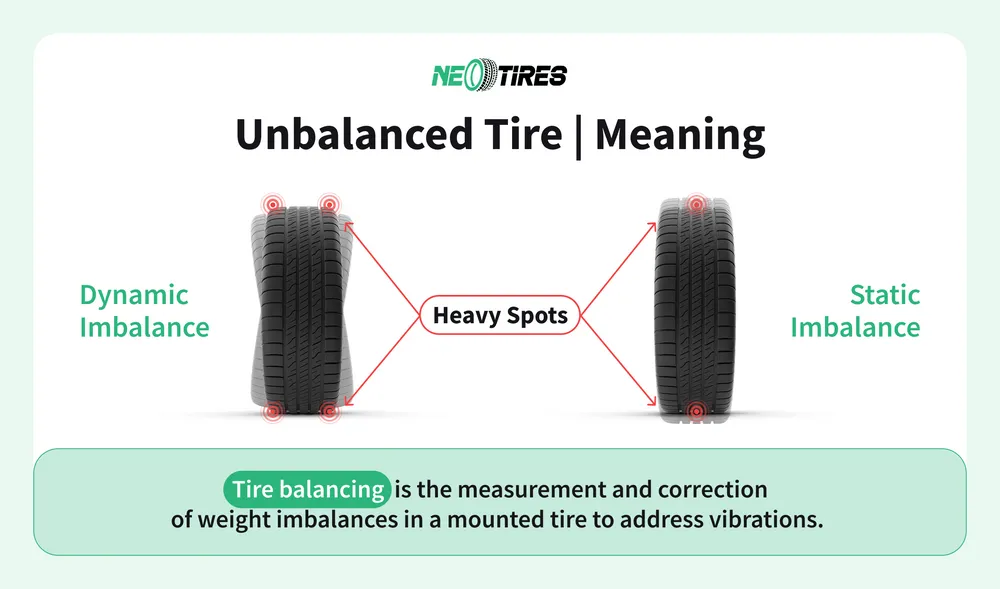If you drive a car in the U.S., you’ve probably heard the term tire or wheel balancing tossed around at tire shops. Some drivers think it’s optional. Others confuse it with wheel alignment. But proper balancing is one of the simplest services that directly improves tire life, vehicle comfort, and highway safety.
Below is a clear, expert-backed guide to what wheel balancing actually means, why it matters, and when your car needs it.
- What Is Wheel Balancing?
- What Causes Tires to Become Unbalanced?
- What Are the Symptoms of Unbalanced Wheels?
- How Wheel Balancing Helps
- How Tire Balancing Is Performed
- Wheel Balancing Frequency
- Is Wheel Balancing the Same as Alignment?
What Is Wheel Balancing? (Technical Explanation)
Wheel, or tire balancing, is a service that ensures the tire-and-wheel assembly has its weight evenly distributed around the axle. Even a small weight difference of ¼ ounce can cause vibrations at 50+ mph.
During balancing:
- The wheel is placed on a computerized balancing machine.
- The machine measures heavy and light spots (static or dynamic imbalance).
- A technician installs small wheel weights to counter these variations.
Even new tires and wheels naturally have slight variations in mass, and balancing ensures the assembly rotates smoothly at all speeds. Tire balancing ensures the wheel rotates evenly, preventing vibrations and premature tire wear.
What Causes Tires to Become Unbalanced?
Imbalance can occur naturally or due to service-related issues. The following six factors can lead to wheel imbalance: normal tire wear, manufacturing variations, road impacts, new tire mounting, lost wheel weights, or wheel misalignment. Here is how each factor can affect wheel balance:
Normal Tire Wear
As tires wear, they lose rubber unevenly. Even high-quality tires develop slight mass differences over time.
Manufacturing Variations
Tire and wheel manufacturers allow small weight tolerances; no assembly is ever perfectly uniform.
Road Impacts
In the U.S., potholes, speed bumps, and debris are common causes of wheel weight loss or rim deformation.
New Tire Mounting
Even properly installed new tires require balancing because rubber density isn’t uniform from end to end.
Lost Wheel Weights
Weights can fall off due to corrosion, snow/salt, aggressive driving, or hitting debris.
Wheel Misalignment or Suspension Issues
Although separate from balancing, poor wheel alignment or worn suspension parts can quickly create uneven tire wear, eventually leading to wheel imbalance.
What are the Symptoms of Unbalanced Wheels?
Symptoms such as vibration at speed, unusual/early tire wear, noises like wobbling, lower fuel efficiency than usual, lower highway stability (poorer handling) are likely to suggest wheel unbalance.
You should schedule a tire check if you notice any of the mentioned signs; each of them stems directly from how imbalance affects the rotating assembly:
Vibrations at Speed
As an imbalanced wheel spins, its uneven weight distribution creates a repeating wobble. That wobble transfers through the suspension into the cabin:
- Steering-wheel shake usually means the front wheels are unbalanced.
- Seat or floor vibrations often point to the rear wheels.
These vibrations typically show up between 45 and 70 mph, when rotational forces amplify the imbalance.
Uneven or Rapid Tire Wear
Because an unbalanced wheel “hops” or “slaps” the road with every rotation, the tread wears in irregular patterns. You may see:
- Patchy, scalloped, or cupped wear
- High and low spots across the tread
- A louder, rougher ride
Bridgestone’s technical resources link these specific wear patterns directly to imbalance.
Decreased Fuel Economy
An unbalanced tire doesn’t roll smoothly; the vehicle has to work harder to overcome the constant rolling resistance created by the wobbling wheel. As a result, the engine burns more fuel to maintain normal speeds.
Reduced Highway Stability
At higher speeds, imbalance can cause the car to feel slightly floaty, nervous, or less planted on the road. This happens because the oscillation from the wheel disrupts the vehicle’s straight-line stability.
How Wheel Balancing Helps
Wheel balancing offers several benefits, including eliminating wheel vibrations, preventing early tire wear, protecting the suspension, improving precision/handling stability, and ensuring optimal fuel efficiency. Here is the breakdown:
Reduces Steering Wheel Vibrations
When a wheel has uneven mass, it creates a “heavy spot” that pulls outward as the wheel rotates. This generates a centrifugal force that repeats with every rotation. At 50 to 70 mph, this force becomes strong enough to travel through the suspension and into the steering wheel.
How Balancing Fixes It
The balancing machine finds the exact location and size of the heavy spot in the wheel. The technician then installs weights directly opposite that spot to equalize mass around the wheel’s axis, removing the rotational force that caused the vibration in the first place. The procedure leads to a smooth, vibration-free ride at any speed.
Prevents Uneven and Rapid Tire Wear
A wheel with an imbalanced weight does not roll smoothly; it hops or bounces slightly as it turns. This small bounce repeatedly forces parts of the tread against the road.
How Balancing Fixes It
Balancing corrects the weight distribution and ensures the tire rotates in a perfect circle without vertical or lateral movement. This stabilizes the contact area so every part of the tread touches the road evenly. As a result, the tire wears evenly and lasts for its intended lifespan.
Reduces Stress on Suspension and Wheel Bearings
When a wheel is unbalanced, the repeating vibration acts like a constant hammering force transmitted into suspension components. This increases the dynamic load on shocks, struts, bushings, control arms, or wheel bearings. Wheel bearings are particularly sensitive because imbalance forces travel directly through them at every rotation.
How Balancing Fixes It
Balancing eliminates the oscillating forces that would otherwise be transmitted to the suspension. With the wheel rotating smoothly, components receive a stable, predictable load instead of repetitive impacts.
As a result, suspension lasts longer and maintains factory-level ride quality.
Helps Maintain Fuel Efficiency
An unbalanced wheel increases rolling resistance. Because the wheel doesn’t rotate smoothly, the vehicle must continually apply more power to maintain the same speed.
How Balancing Fixes It
When weights are added and the tire rotates evenly, rolling resistance is minimized. A smooth, balanced wheel requires less energy to turn. As a result, the engine works more efficiently, helping maintain optimal fuel economy.
Restores Highway Stability and Handling Precision
Imbalance creates alternating forces (up-and-down or side-to-side) on the wheel. This disrupts the tire’s ability to maintain a consistent contact patch with the road, leading to vague steering feel, reduced traction consistency, lower braking stability, and wandering at highway speeds.
How Balancing Fixes It
Balancing stabilizes the wheel’s rotation, keeping the tire planted and maintaining continuous contact with the pavement. As a result, the vehicle tracks straight, steering response improves, and braking becomes more predictable.
How Tire Balancing Is Performed (Step-by-Step)
Tire balancing can be done at a tire shop with specialized equipment or at home, if you have the right tools and necessary knowledge. Professional balancing is the most accurate and reliable method. It uses computerized machines to find and fix imbalances in just a few minutes. While you can try DIY balancing, it needs costly equipment and skills that most car owners lack. Below, you have both methods explained:
Tire Balancing at Service Shops
A modern tire shop typically uses a dynamic balancer, which measures both vertical and lateral imbalance. The process implies the following steps:
1. The tire and wheel are mounted on the balancer.
- The machine spins the wheel at a speed to detect weight variations.
2. The machine identifies heavy and light spots.
- These spots are displayed in ounces or grams.
3. The technician installs corrective wheel weights.
- Two types are commonly used in the U.S.:
--> clip-on weights (steel or zinc)
--> adhesive stick-on weights (common for alloy wheels)
4. The wheel is spun again to confirm perfect balance.
Balancing typically takes 10 to 15 minutes per wheel and can cost about $40 - $75 for a complete set of wheels, depending on where you live, your service provider, or tire size.
Balancing Tires at Home
It’s technically possible to balance your tires at home, but it’s not recommended if you lack proper tools, because accurate balancing requires:
- a calibrated dynamic balancer
- knowledge of weight placement
- the ability to read imbalance measurements
Mechanics have all the necessary tools at their service stations, ensuring all wheels are balanced correctly after a thorough check. Without proper tools, DIY balancing rarely solves vibration issues.
Wheel Balancing Frequency (USA Guidelines)
Most U.S. tire professionals recommend balancing tires:
- Every 12 months
- Every 6,000-8,000 miles (often paired with tire rotation), or
- Anytime you install new tires
- After hitting a severe pothole or curb
- If vibrations appear at highway speeds.
These intervals align with recommendations from the U.S. Tire Manufacturers Association (USTMA) and major tire brands like Michelin and Continental. It’s strongly advised to follow your tire manufacturer’s recommendations.
Is Wheel Balancing the Same as Alignment?
No, wheel balancing and alignment are two different things. Balancing focuses on the rotation of the wheel-and-tire assembly. It fixes small weight imbalances that can cause the wheel to wobble or vibrate at high speeds. Alignment, on the other hand, adjusts the angles of the wheels: camber, toe, and caster; so the tires contact the road correctly. These two maintenance procedures tackle different issues, use different equipment, and target different parts of the vehicle.
Car Maintenance Procedure | Wheel Balancing | Wheel Alignment |
What it corrects | Corrects uneven weight distribution | Corrects wheel angles (camber, toe, caster) |
Where it is performed | Performed on the wheel/tire assembly | Performed on the suspension system |
What symptoms it majorly fixes | Vibration caused by uneven weight distribution in the wheel–tire assembly. | Pulling, drifting, and uneven tire wear caused by incorrect wheel angles. |
Tools it uses | Uses wheel weights | Uses angle adjustments |
Why Trust NeoTires?
Neotires has served U.S. drivers for over 6 years, with each team member having years of hands-on automotive experience. Our team stays aligned with the U.S.-based safety standards from organizations such as NHTSA, AAA, and USTMA technical data.
We partner with reputable manufacturers and continue to refine our guides and recommendations through real-world testing, professional guidance, and customer feedback. When you shop or service with NeoTires, you get expertise, transparency, and long-term value. Contact us for any tire-related matter, or find suitable tires by size, vehicle, or brand for your needs. We provide and ship tires for all driving conditions, including daily driving, off-road, agricultural, and farming.
Drive safe and balance your tires timely!









